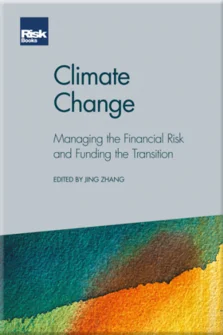Embedding climate change in financial metrics
Natalie Ambrosio Preudhomme, James Edwards, Juan Licari and Olcay Ozkanoglu
Foreword
Introduction
Sustainability for critical ecosystems: The future of risk management – more of the same or a new paradigm?
Climate change is a source of financial risk
The climate disclosure landscape in the finance sector
Green boxes? An overview of climate risk tools and analytics
Embedding climate change in financial metrics
Modelling climate physical risks
Climate-related stress-testing: Transition risks
Catastrophe risk modelling and climate change
Evidence-based climate stress testing
Climate risk drives a new paradigm in risk management
Incorporating climate change in asset allocation and portfolio construction
(Car)bon voyage: The road to low-carbon investment portfolios
Climate risk primer for community banks: Concepts and policies during a period of significant change
Next-generation analytics for climate finance
Climate finance post-COP26
Mobilising private funding
Climate change has emerged as a key and increasingly material risk factor in financial decision-making. As extreme temperature records break one after another, and increasingly devastating storms and wildfires are experienced around the globe, awareness is growing that investments and loans are exposed to climate risk based on the exposure of underlying physical assets. Likewise, as nations announce net zero commitments and companies sign on to ambitious pledges, consumer sentiment around greenhouse gas (GHG) emissions is shifting, and demand is growing for governments to finance the transition to a low carbon economy. Supervisory expectations are also changing, with nations around the world recommending a new generation of financial reporting in line with the Task Force on Climate-related Financial Disclosures (TCFD). Several countries, including New Zealand and the UK, are moving towards mandatory climate risk disclosure, and central banks such as the Bank of England are requiring climate stress tests for banks and insurers. The acknowledgement of climate risk as a systemic financial risk is here, and it calls for the development of metrics to quantify risk exposure and inform
Copyright Infopro Digital Limited. All rights reserved.
As outlined in our terms and conditions, https://www.infopro-digital.com/terms-and-conditions/subscriptions/ (point 2.4), printing is limited to a single copy.
If you would like to purchase additional rights please email info@risk.net
Copyright Infopro Digital Limited. All rights reserved.
You may share this content using our article tools. As outlined in our terms and conditions, https://www.infopro-digital.com/terms-and-conditions/subscriptions/ (clause 2.4), an Authorised User may only make one copy of the materials for their own personal use. You must also comply with the restrictions in clause 2.5.
If you would like to purchase additional rights please email info@risk.net










